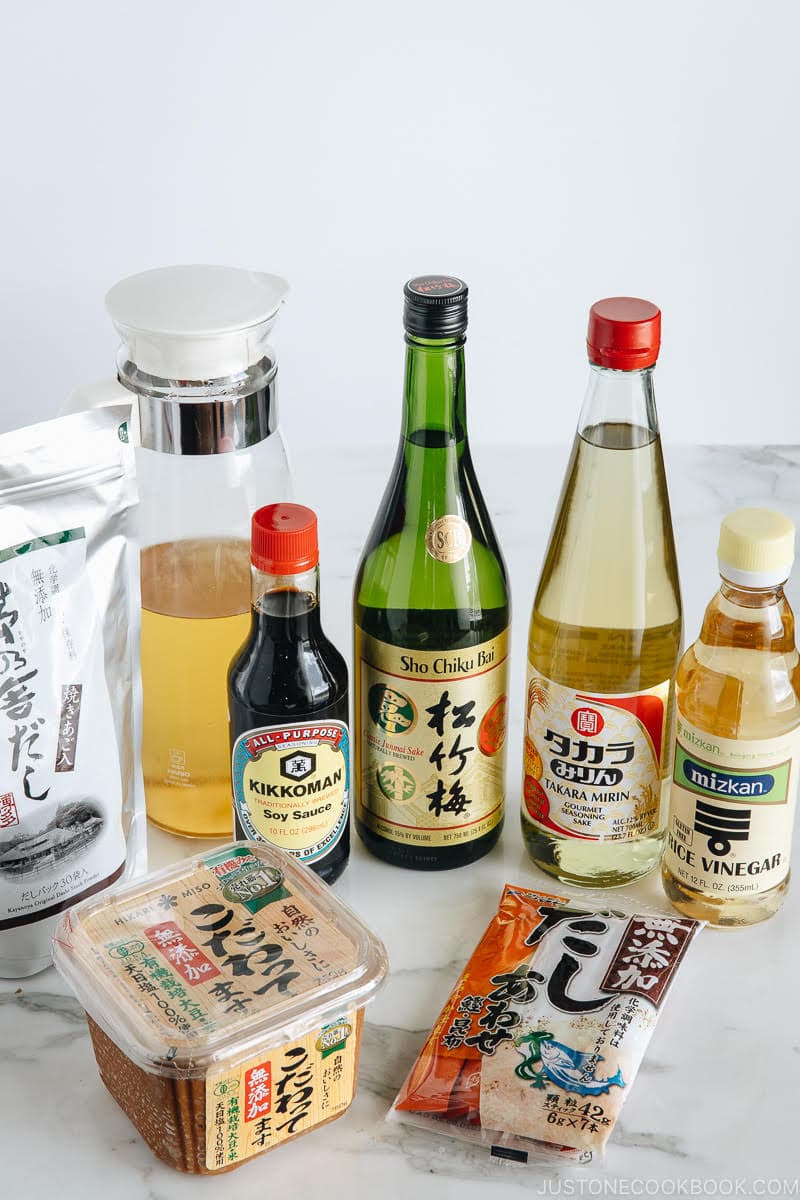
Love Japanese food but not sure where to start? We have great news for you. All you really need is 6 condiments to start making your favorite Japanese food at home!

I have often heard that people are intimidated to cook their beloved Japanese dishes at home. There seems to be a misconception that cooking Japanese food is unduly complicated. That it requires obscure ingredients, long hours and expert skill that they are best left to the pros. Believe it or not? I am here to tell you that making flavorful and healthy Japanese food is easier than you think!
Today I’ll show how you can get started by building the most basic Japanese pantry with these 6 must-have condiments. They are easily accessible and often used in combination in most Japanese recipes. Each one works together to bring out the umami flavor that Japanese cuisine is known for.
Coupled with some background knowledge, cooking Japanese food is easily within your grasp. Ready? Let’s have a look!
6 Must-Have Japanese Condiments in Your Pantry
Below you’ll find a brief introduction for each condiment. If you want to read more more about it, click on the title or the picture. It will take you to a more comprehensive page on the uses, storage, recommended brands, substitutions and more.
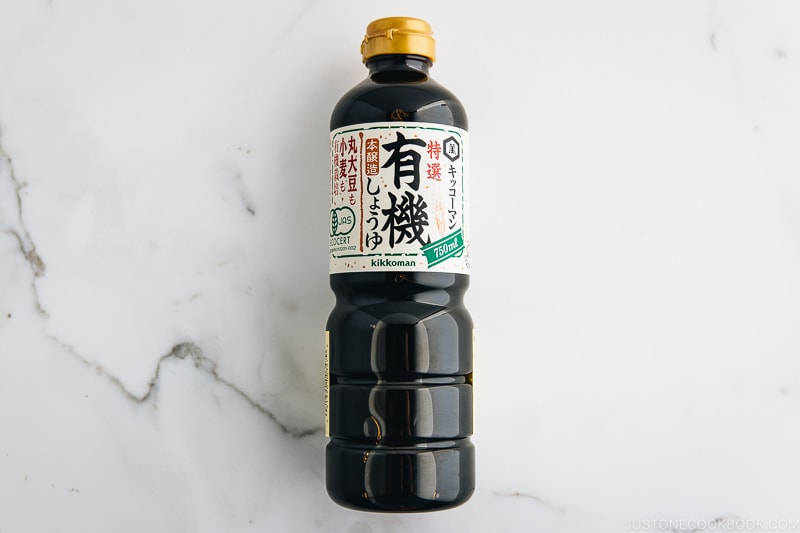
1. Soy Sauce
Soy sauce (also known as Shoyu, 醤油) is the foundation of Japanese cooking. Made from soybean, wheat, and salt, and fermented for several months, it is used as a key flavoring to season a dish. Even though soy sauce is salty, its main role is to add a touch of savoriness or what we call the umami to a dish. Whereas salt is used to bring out the flavor of the ingredients, so very often you’ll find us using both soy sauce and salt together in recipes.
There are different strengths of soy sauce which is characterized by its aging process, thickness, and sodium level. Each brand of soy sauce tastes slightly different from another, so please adjust the amount to suit your taste. In the US, you may also come across tamari soy sauce that is marketed for gluten-intolerance consumers. It is slightly thicker, richer, and darker than regular soy sauce, but you can definitely use tamari to replace soy sauce if that’s your preference.
Where to buy: Nowadays soy sauce is as common as ketchup. You can find a wide variety of soy sauce available in majority grocery stores and online stores. There are also various options for gluten-free soy sauce in the market.
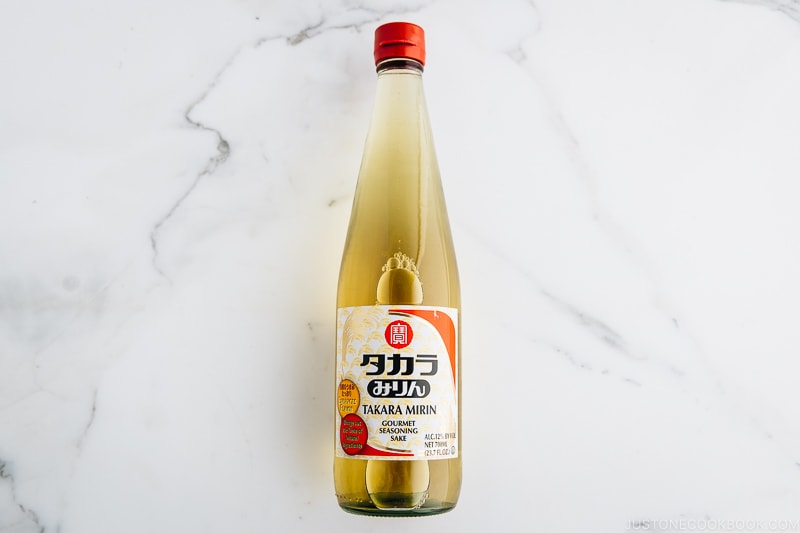
2. Mirin (Japanese Sweet Rice Wine)
Mirin is a sweet syrupy liquid used as a seasoning and glazing agent in Japanese cooking. It is also a type of rice wine but with lower alcohol content. The key roles of mirin are to add luster, help tenderize meat/seafood, and add a mild sweetness to dishes. It is an essential ingredient in making teriyaki dishes.
You can find 4 different types of mirin: hon mirin (“real” mirin), mirin, mirin-like condiment, and mirin-type condiment. I use Hon Mirin from Japan because I believe it makes a difference but it is hard to find outside of Japan. My next recommendation is Takara Mirin.
Substitute: You can substitute mirin with sake and sugar, although it won’t be exactly the same.
Where to buy: You can purchase mirin from Japanese grocery stores, Asian supermarkets, or Amazon.

3. Sake (Japanese Rice Wine)
Japanese use sake for cooking, just like how you would with wine. Pronounced as SAH-keh, sake is made from rice and water through a brewing process like beer. We use it as marinades for meat and fish to tenderize and to remove their smell. It also adds umami and a naturally sweet flavor to a dish. Compared to Chinese Shaoxing wine, sake is more delicate and mild, so it is suitable for soups, sauces and simmered dishes.
Substitute: If you can’t find sake or cooking sake, you can substitute with dry sherry or Chinese rice wine, but bear in mind that they are stronger in taste. If you cannot consume alcohol in your cooking, you can simply omit sake, or replace it with water or broth.
Where to buy: You can find inexpensive bottles ($5-8 shown above) at the alcohol section in Japanese or Asian grocery stores. Nowadays, WholeFoods Market and even Target also carry sake in their alcohol department. Some well-stocked liquor stores do carry sake as well.
Wait, what’s the difference between Sake and Mirin?
Sake and mirin are quite similar. If you want to learn more about the differences between them, click here.
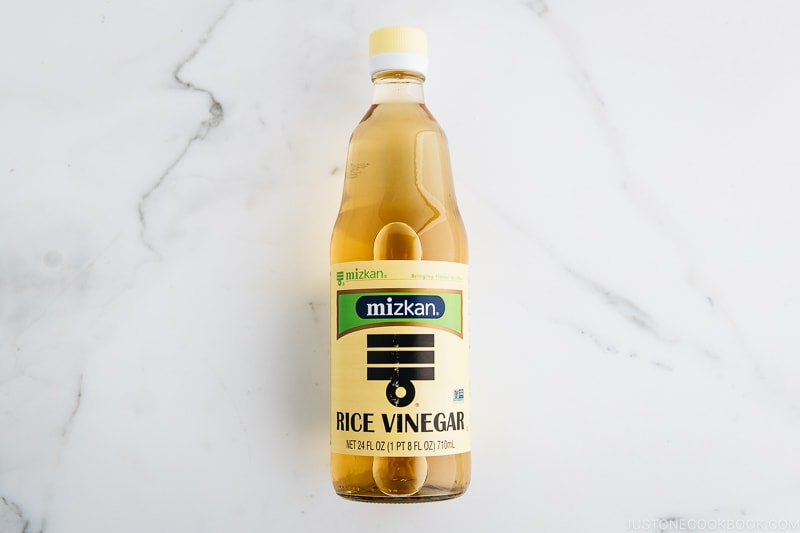
4. Rice Vinegar
Made from rice, rice vinegar (米酢) is sweeter, milder, and less acidic than western vinegar. It lends a mild tangy, sourish yet fruity notes to the dish. We use it to make sushi vinegar seasoning to make sushi rice, Japanese-style salads, pickles, and various sauces.
Where to buy: You can find rice vinegar in the Asian aisle of the majority of grocery stores.
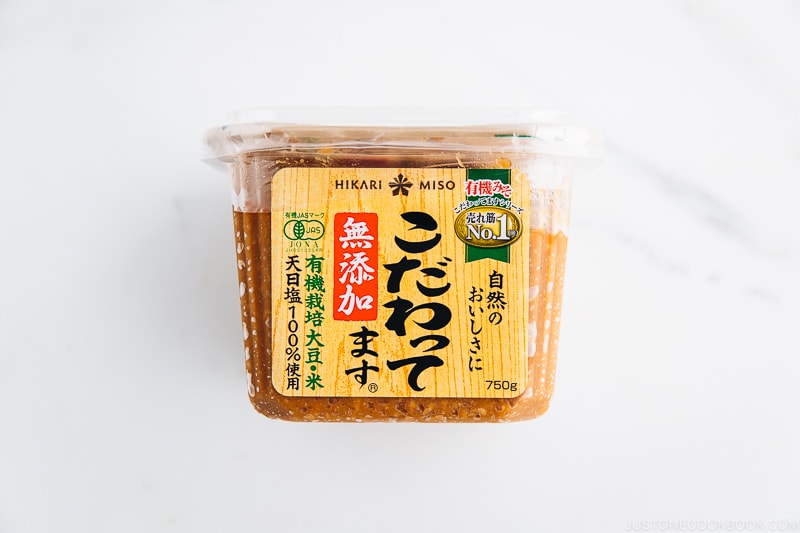
5. Miso
Miso (味噌) or fermented soybean paste, is made from soybeans, grains, salt, and koji culture. There are many different types of miso out there, but you can broadly categorize them based on colors: red, white and yellow. Each miso varies in terms of taste, aroma, texture, and saltiness. If you are new to miso, start with yellow miso (also known as Awase miso) for its versatility. You can literally use it in any recipes that need a flavor boost.
Where to buy: My favorite brand for miso is Hikari Miso and you can find their miso products at Japanese and Asian grocery stores, or selected miso on Amazon. Alternatively, look for miso brands that have no MSG or other additives. You should be able to find some food brands at Whole Foods, local co-ops or well-stocked grocery stores in the refrigerated section.
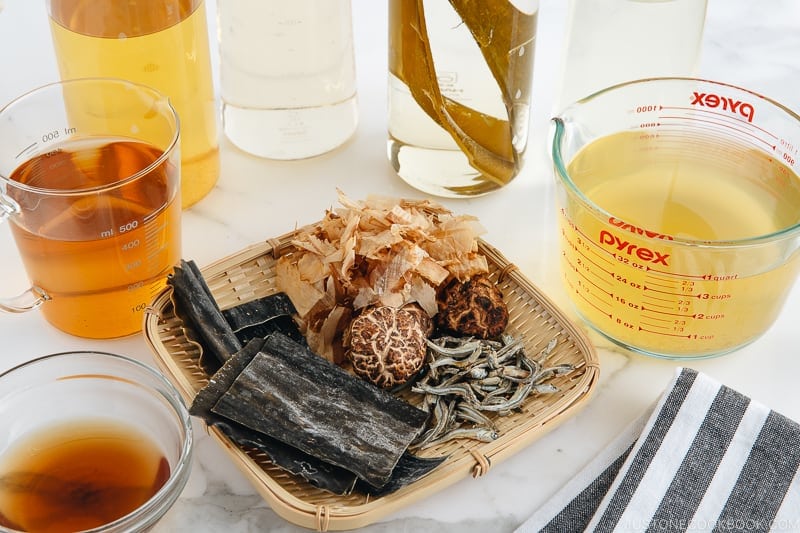
6. Dashi (Japanese Soup Stock)
Dashi (だし, 出汁) is the quintessential soup stock used in many Japanese dishes. From miso soup to ramen to chawanmushi, the uses of dashi are unique and expansive in Japanese cuisine. It defines Japanese food with its unique, delicate yet umami-packed flavor. Besides being used as a broth base for Japanese hot pots, noodle soups, and simmered dishes, dashi is also used as a seasoning liquid or as an addition to sauces. You can literally use it in dishes that call for a touch of liquid.
Another great thing about dashi? It is the easiest soup stock to make from scratch. There are different methods you can choose to prepare dashi which I talk in details in the Ultimate Guide in Making Dashi.
For vegans and vegetarians, you can make dashi with kombu or a combination with shiitake mushrooms!
Popular Japanese Food Made with 6 Must-Have Condiments
There you have it. With these 6 simple condiments in your pantry, you are literally set to cook up some of your favorite Japanese dishes at home!
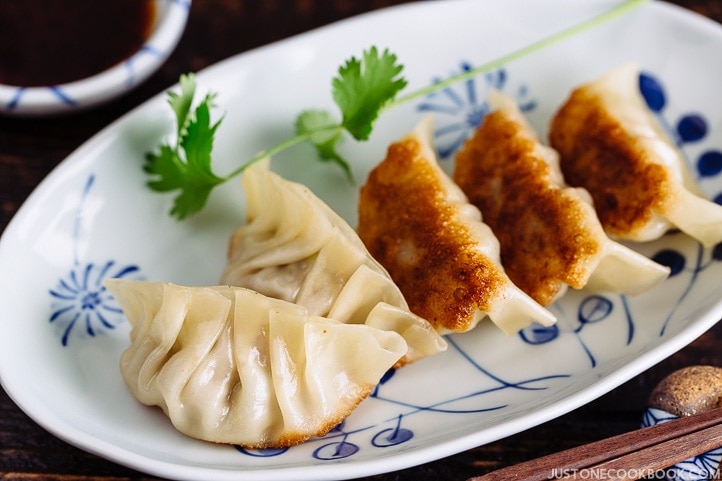
Appetizers:
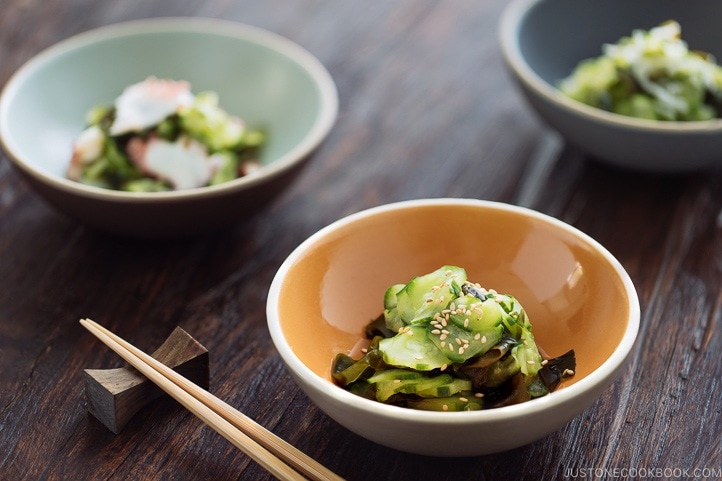
Salads:
- Wafu Salad Dressing (Japanese Salad Dressing)
- Salad with Carrot Ginger Dressing)
- Sunomono (Japanese Cucumber Salad)
- Soba Noodle Salad
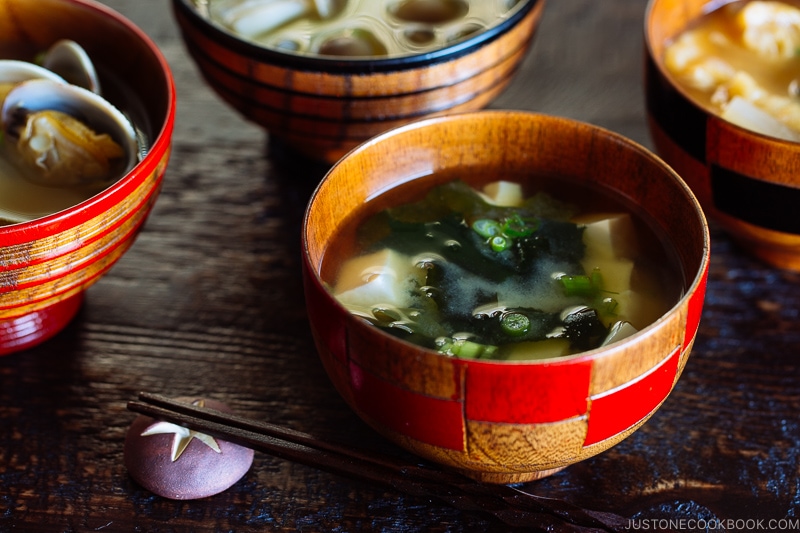
Soups, Noodle Soup & Hot Pot

Main dishes:
- Chicken Teriyaki
- Miso Butter Salmon
- Kakuni (Braised Pork Belly)
- Chicken Karaage
- Teriyaki Salmon
- Oyakodon
- Gyudon
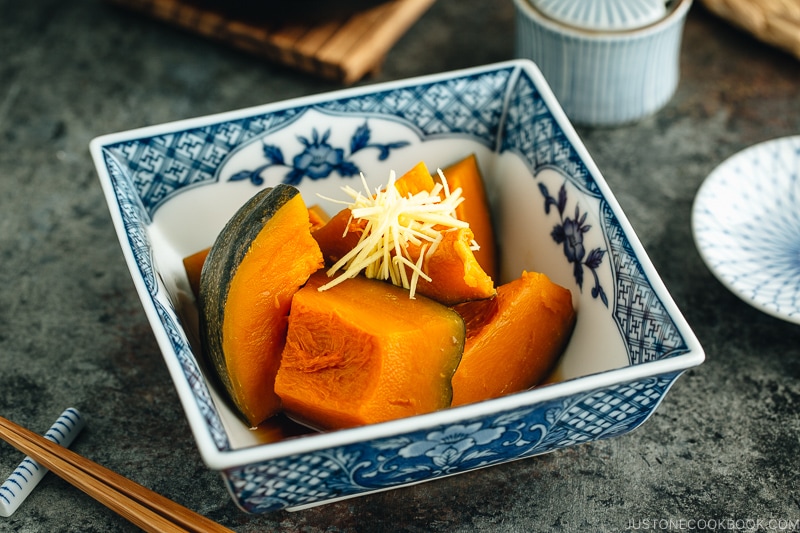
Side dishes:
- Tamagoyaki (Japanese Rolled Omelette)
- Spinach with Sesame Miso Sauce
- Simmered Kabocha
- Nikujaga (Meat and Potato Stew)
- Takikomi Gohan (Mixed Rice)
For more cooking fundamentals, check out the resources below:
- Local Japanese grocery stores around the world
- Everything you need to know about Japanese rice
- What is the difference between soba and udon noodles
- 5 must-have Japanese kitchen tools
- A beginner guide on how to build a kitchen for Japanese cooking
